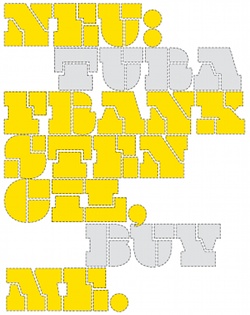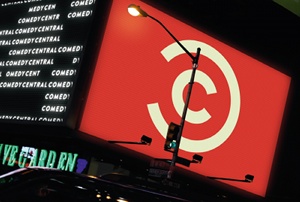Made by Many: Many hands, one vision
ITV, British Airways and Skype are just some of the clients Made by Many has worked with on its quest to make “new stuff out of the internet”. Tim Malbon and Tom Harding explain why the studio’s approach is anything but traditional
See inside Made by Many in our Studio Life film, at the bottom of this article.
“I’ve always loved the web because of its disruptive power. It’s rewiring everything and re-making the world,” begins Tim Malbon, co-founder of digital product and service design company Made by Many. It was during his time working as creative director at media agency Interesource, back in 2003, that Malbon met fellow ‘creative technologists’ Isaac Pinnock, Stuart Eccles and William Owen, who shared his obsession for the behaviour emerging from digital experiences.
“We were all fascinated by the read/write revolution and the effect of new media on the traditional, old media world,” he explains. “We were interested in the way open-source software and new working methodologies were already making the established new media players uncompetitive.”

Having worked in the digital industry since the 90s, the quartet witnessed firsthand the social, cultural and political effects that the internet was having on the world – and it excited them. Their expertise and experience in the field, combined with the desire to be creative, drove them to set up a company that would offer a new way of working and move with the rapidly changing times. Malbon explains: “We shared a love of making stuff and a determination to create a digital shop that balanced business consulting, technology and design, instead of skewing towards one of them. We wanted to create a company that embraced radical change, rather than running scared from it.”
So, in September 2007, they set up Made by Many inside the London office of global advertising agency BBH, in its old library space. “The deal was: a roof over our heads, plus a million quids-worth of coffee, in return for time,” he grins. “We made lots of friends and it helped us to understand what we actually do, and why – as well as what we don’t do: traditional marcomms and campaigns.”
After a few years, the team outgrew BBH’s old library space and in 2010 moved to a new office in Diespecker Wharf, Islington. “Moving was weird – like growing into a new skin,” Malbon says. “But it opened up our eyes, minds and horizons, and it gave us the impetus to articulate the differences between ourselves and traditional agencies; both the weaknesses and strengths.”
Made by Many’s approach to work is anything but traditional – and that’s the way they like it. “We’re basically trying to make stuff at the same speed as you can dream it up, test it, design it and iterate it; again and again – often using live software prototypes and real customers,” explains Malbon. To achieve this workflow, the studio founders brushed away older methods of creating web applications, such as the waterfall model. Previous experience led them to believe that this sequential, linear process was inefficient, and that often, by the time a working prototype was released, the design was out of date. Instead, Agile software development methodologies and ‘lean start-up’ techniques were applied to the way Made by Many works as an agency. Both encourage a culture of working fast and efficiently, as well as responding to and working with change.

This unique, confident approach is clearly part of the studio’s attraction: “We found that clients were keen to experiment, and liked the user experience quality and speed at which we worked,” says Malbon.
As the name indicates, the creative process at Made by Many is extremely collaborative, with clients very much made to feel part of the team. “We try and co-locate for at least part of a project – usually the ‘vision phase’ at the beginning, where we develop the core proposition,” he says. To identify exactly what a client wants, the team also sets some ‘discovery’ activities, enabling the agency to gain a clear idea of the context, background and overall problems that need to be solved.
The general studio setup also throws out conventional working practices, with no departments or job titles: “We value ego-less teamwork above all else – I’m not sure there’s any other way to make products and services that work in the new, on-demand, customer-driven world.”
Senior designer Tom Harding has worked for the studio for three years, after joining from an internet start-up company. “When I was looking for work, Made by Many stood out because they were really open on their blog about what they did and how they did it,” he explains. “To me, they approached design differently to other agencies: they really focused on designing for the user, incorporating new and exciting technologies.”
When asked to name his favourite project so far, Harding recalls working for one of the biggest and most respected newspapers in Brazil, Valor Econmico: “We helped them redesign their digital offering and bring a new one – Valor Investe – to the market,” he explains. “I’ve been interested in the future of news for a long time and this was a fantastic opportunity to design an experience that addressed a lot of things that I feel many news organisations miss.”
The project is openly discussed on the studio’s blog, where team members are encouraged to share their work and things they have learned online. “We’re very competitive, but we’ve always loved being radically transparent because of what it brings you in return: brilliant people to work with, clients who want to take risks and move things on, and interesting work.”

One such example of this – and a favourite project of Malbon’s – is the studio’s ‘Skype in the Classroom’ project. When Skype realised that teachers were using its service in innovative new ways to collaborate with other educators around the world, it challenged Made by Many to think of ways to encourage others to use it similarly. “The traditional response would have been to create a microsite profiling some of the teachers; possibly some short films using the examples to ‘inspire’ other teachers,” says Malbon.
Instead – and with Skype’s permission – the studio delved a little deeper to develop some real user-based alternative propositions: “We believed, although we had no evidence to start with, that we could be more successful by layering a special service for teachers on top of Skype’s basic free functionality,” he explains. “Skype clearly understands how to make a great product, and by giving us the green light on this alternative approach we ended up somewhere much more interesting and effective. That’s what we love about this project; it’s such a neat encapsulation of what we do at Made by Many and why,” he continues.
Soon that won’t be the only thing that Made by Many does, with Malbon revealing the beginnings of a lab starting in the London office. “There are quite a few of us who’d like to make more physical bits of the internet – stuff that bridges the gap between real and virtual.”
He grins: “I think we believe that the web has given us all superpowers. It would be a shame if all we could do with them is play Angry Birds, check our Klout scores and ‘Like’ things.”
Daily design news, reviews, how-tos and more, as picked by the editors.

The Creative Bloq team is made up of a group of art and design enthusiasts, and has changed and evolved since Creative Bloq began back in 2012. The current website team consists of eight full-time members of staff: Editor Georgia Coggan, Deputy Editor Rosie Hilder, Ecommerce Editor Beren Neale, Senior News Editor Daniel Piper, Editor, Digital Art and 3D Ian Dean, Tech Reviews Editor Erlingur Einarsson, Ecommerce Writer Beth Nicholls and Staff Writer Natalie Fear, as well as a roster of freelancers from around the world. The ImagineFX magazine team also pitch in, ensuring that content from leading digital art publication ImagineFX is represented on Creative Bloq.
